Taiwan 2023
Travelling to my favourite Continent - Exploring the Wonders of Taiwan
I really wanted to travel to Asia again, so I decided to travel to Taiwan, since I always heard, how amazing the Taiwanese food is. Moreover, it was a chance to meet my friend Ignacio again. We have met the last time in Göttingen seven years ago. Luckily, I also got some really nice advices from one of my colleagues, who stayed in Taiwan for one year. I was so thankful for all those suggestions, what to do and to eat in and around Taipei, because I had to stay the most time of my visit in the North of the island due to a typhoon, which hit the island in the first week of my vacations. So it wasn't possible for me to explore the South of the island, which is also a chance for me to come back to Taiwan again soon.
The first days in Taipei, I had to get used to the heat and the high humidity. It was really exhausting, because I preferred to walk around to explore all the interesting parts of the city. I was always afraid, I could miss something, if I'd take the MRT. Nevertheless, later on during the trip, I took the MRT more often, because it was really relaxing and cheap to go through the city. But as mentioned, I started to walk from my hotel close to the main train station to the Taipei 101 World Trade Centre during the first day. I really wanted to see it on a sunny and clear day, so I wanted to take the first chance I got. When I arrived, I was really impressed by the building itself. Then, I also wanted to go up to the 89th Floor Observatory, to have a 360° view of the city from the top of the tower. I would say, it was nice, but after I went down again, I decided to make a little walk to the Elephant Mountain, one of the suggestions of my colleague. Unfortunately, my GPS showed me a wrong way and so I needed to walk through a little jungle to reach the summit of the mountain - on the way back, I used the normal stairs, which would have been better on the way up too to reduce the number of mosquito bites. Here, I enjoyed a spectacular panoramic view of Taipei and I waited until it got dark. Meanwhile, I started to talk with a girl, who was also waiting for the sunset. Since I didn't have other plans for the rest of the evening, Diana asked me to join her and her German friend for a Taiwanese dinner, which was absolutely perfect, since it was in an authentic Taiwanese restaurant. Here I got in contact with stinky tofu, spicy eggplants, Taiwanese style fish and shrimp balls. It was definitely a successful first day in Taiwan.
I really liked, that Taipei has so many green areas to relax and to escape from the hectic city life. Close to my hotel, I had the 228 Peace Memorial Park, a park which contains memorials to victims of the Feburary 28 Incident of 1947, including the 228 Memorial Monument in the centre of the park. The February 28 Incident was an anti-governemnt uprising in Taiwan that was violently suppressed by the Kuomintang, where thousands of civilians were killed. The incident is considered to be one of the most important events in Taiwan's modern history and was a critical impetus for the Taiwanese independence movement.
A bit further, it was possible to visit the Chiang-Kai-shek Memorial Hall, a huge monument and temple-like building in memory of the former president of Taiwan Chiang Kai-shek. The roof of the Memorial Hall is blue and octagonal, a shape that picks up the symbolism of the number eight, a number traditionally associated with abundance and good fortune in China. The Memorial Hall Square is flanked on the north and south by the National Theatre and the National Concert Hall.
The biggest of the parks is the Daan Forest Park, which was created in 1994 after the eviction of longtime squatters and the demolition of illegal buildings on muncipal land. This park seemed to be the green lung of the city, giving the opportunity for many outdoor activities inside the city. It also had a little lake and opportunities just to enjoy the calmness of the nature.
One of the biggest highlights were the cute tea houses. When I planned my stay in Taipei, I found a couple of promising tea houses in the city. At the end, I just went to the Wistaria Tea House and the Eighty-Eightea Rinbansyo. I was so fascinated by both of them, that I always came back and here I was thinking like, "I should go back to the places, I liked", especially with the traditional Japanese kind of tea ceremonies. During the time in Taiwan, I drunk so much Oolong tea and enjoyed so many great Taiwanese and Japanese snacks like pineapple cake, mochis or mung bean cakes. I also bought a lot of snacks, so while being back in Freiburg, I can also drink the super tasty Oolong tea with delicious tea snacks.
From the main train station in the southern direction, I reached Ximending, an international and Japanese style entertainment district with Taipei's first pedestrian area since the late 1990s. Especially at night, it's a busy and crowded district, where I got the best scallion pancakes and dangos at Don Don Donki. All the colourful streets and advertising were quite interesting and overwhelming - like the lanterns or the rainbow crosswalk. Ximending also became a well-known theatre street in Taipei with the 1908 built Red House Theatre.
On the way to the Lungshan Temple, I passed by the Bopiliao Historical Block. At its peak during the Qing Dynasty period in the late 19th century, Bopiliao was one of the busiest and most prosperous commercial areas in Taipei, home to various merchants and was one of the major areas for the coal trade. During the Japanese occupation, new roads were constructed to connect various parts of the city together and this new connectivity within the city diminished the relevance of the area and it fell into disrepair. In the early 2000s, the Taipei City government worked to restore the historic architecture of the area and established the Heritage and Culture Education Centre to protect the legacy of the area.
The next destination was the Lungshan Temple, close to the Bopiliao area. The temple was built in Taipei in 1738 by settlers from Fujian. In addition to its Buddhist elements, it includes halls and altars to Chinese deities such as Mazu and Guan Yu. I really liked the beautiful decorations in the whole temple area including all the beautiful lanterns, the flowers or the waterfall.
To the northern side of the main station, I walked to the Dihua Street, which was the city's largest wholesale and retail market since the 19th century. A wide variety of goods such as dried or canned food from the land and sea, tree mushrooms, dried fish or squid could be bought here, as well as Chinese medicine and textiles. A stroll
along Dihua Street, dotted with European-style houses, offers a glimpse
of traditional Chinese businesses such as bamboo shops, rice mills,
incense sticks and lantern shops. In the hustle and bustle of the street, it was also possible to try delicacies. By accident, I found the Huayin Street, a street full of lanterns. At first, I just explored the street during the daytime. But I also came back at night to see the beautiful shining Chinese lanterns. It was super beautiful to enjoy the lantern street and it reminded me a little bit of Hoi An in Vietnam.
Everything in Taiwan was fantastic, but of course, the food was the best. On the night markets, it was possible to try so many different kind of foods - from fresh fruits, "Hujiao Bing" black pepper buns or simple beef noodles at the Raohe Street Night Market. In general, the Raohe Night Market was the best address for the dinner in my opinion. Only once, I tried the Shilin Night Market, which is often considered to be the largest and most famous night market in Taiwan. The food there was also delicious, but I had the feeling, that there was more variability at the Raohe Night Market. I tried food like the mentioned black pepper buns, which I only found here, egg shaped cake skewers with red bean paste, sweet potato balls, plum-flavoured sweet potato fries, fried spicy dumplings, beef noodles, fish balls, Korean cheese sausage and many more.
Apart from the night markets, I also once went to Din Tai Fung. It's a Chinese cuisine restaurant chain in Taipei and I decided to go to the one on the basement of Taipei 101. At first, I needed to get a ticket with a number and since I needed to wait for almost 90 minutes to get a table, I was exploring the mall and souvenir shops. When I finally could enter the restaurant, I ordered the famous "Xiaolongbao" and "Lu Rou Fan". After eating the dumplings there, I could understand, why everyone was saying, that these are the best ones. Moreover, I also once went to Moon Moon Food to meet my Taiwanese friend Ignacio and his wife Michelle. Funnily, I was first waiting in front of the wrong restaurant, since Moon Moon Food had two branches very close to each other. But luckily, I noticed my mistake and I could meet my friend for a great dinner together.
While the typhoon reached the east coast of the island and the rain was coming over to the northern parts, I was doing a tour with a group to the Yangmingshan National Park. The national park is well-known for its cherry blossoms in the spring season, the hot springs, sulfur deposits, fumaroles and hiking trails. Unfortunately, it was too foggy to see the beautiful surroundings with wide green forests and the so called "Grass Mountain", but still, the forest hike was very beautiful. After the hike, we went to Xiaoyoukeng, a post-volcanic geological landscape area. It wasn't possible to see the volcanic lake, but there was an unpleasant smell of sulfur in the air. Moreover, we could see a small geyser on the way back, before we took a relaxing footbath in one of the hot springs.
The next destination of the tour was Houshan Park with the famous Flower Clock, made with seasonal flowers. Within and around the park, it's possible to find a unique flora depending on the season, including cherry blossoms, azaleas, camellias, peach blossoms, thorn apples and plum blossoms. After walking half an hour around the park, we went back to Taipei to visit the last stop for the day, the Beitou Hot Spring Museum close to the Taipei Public Library. The museum is housed inside a public hot spring bath which was built during the Japanese colonial era. After taking off the shoes, we walked through the building and we learned something about the history of the hot spring culture in Taiwan during the history.
It was still raining due to the typhoon, so I decided to visit the Thousands-Islands Lake and the tea plantations of Pinglin in the southeast of Taipei. Luckily, during the drive to the mountain area, the cloud ceiling cleared up a little bit and so, it was possible to have a marvellous view of the lake. The guide brought us to different spots to overview many parts of the tea plantation hills and the mountain islands. Although it wasn't possible to see far away because of the fog, there was still a mystical atmosphere in the air. After some spectacular views, we went to Pinglin, a famous tea paradise, which is most known for producing pouchong tea. Over 80% of its residents are tea growers or are involved in the tea business. At one of the tea growers house, we had a special tea tasting experience with trying his own green and black teas and delicious peanut pastries. We also learned a lot about the different teas, the plantations, the tea ceremonies and afterwards, we went to the Pinglin Tea Museum, the world's largest tea museum, to reinforce our knowledge about producing the tea leaves from the plantation to the drying process. It was an amazing day, which was completed by a visit of the Raohe Night Market together with Lina, the Swiss girl, I got to know during the tour.
On the northern coast of Taiwan, I could see some geological phenomena. One of them was the Nanya Rock formation, a layered sandstone column, created between 10 and 20 million years ago. The main rock formation was formed by easily eroding sandstone, with the area underneath being eroded away by the sea and waves. In addition to the sandstone formations, there were also different shaped limestone formations called hoodoo stones inside the Yehliu Geopark near Keelung. According to their shape, the rock formations got names like Queen's Head, Candle Rocks, Dragon's Head, Mushroom Rocks or Tofu Rocks. All of them are unique and admirable. It was possible to go to almost all of the stone formations. Only for the Queen's Head, a zoned and guarded area has been set up, because the stone statue has been affected by visitors in the past. So, to take a picture with the Queen's Head, everyone had to stand in a separate queue, which wasn't short. Unfortunately, we only had a limited time to explore the area after waiting in the queue, since it was planned to continue the tour to Jiufen. But I could still take some impressive pictures.
Later on, we had a short stop in Jinguashi, a town, notable for its historic gold and copper mines. It was an important town for the Japanese Empire during Japan's rule over Taiwan. The mines produced substantial amounts of copper and silver - more than anywhere else in Taiwan - and were Imperial Japan's largest sources of gold. Nowadays, the mines of Jinguashi, which means "Gold Melon Rock", are remaining mostly intact.
Jiufen is an old gold mining town, known as "Golden Mountain City" and famous for its scenic views over the surroundings and the Pacific Ocean. The city revived with the film "The City of Sadness", which was the first Taiwanese movie to win the Golden Lion in Venice, and became a popular tourist destination since the 1990s. Moreover, the Japanese blockbuster "Spirited Away" gave Jiufen another boost in popularity, especially as travel destination for Japanese people.
Arrived in Jiufen, we started to walk through the narrow alleys of Jiufen Old Street. The street is a colourful paradise of small food and souvenir stalls together with tea houses. The city is supposed to be a mecca for foodies due to the variety of local food options ranging from fishball soup, sweet taro ball soup or Chhau-a-koe rice cakes. I need to say, that the fishball soup was fantastic and also the sweet taro ball soup as dessert was delicious. After the little snacks, we followed the street to the end to reach the observation platform of the Jishan Street for a wonderful panoramic view, before turning back to the Japanese style Shiqu Road, which is literally a narrow downstairs path. Here, it was possible to find the popular A-Mei Tea House, where I went in for a little tea break, while the other people of the group continued walking to the Old Street. The tea house was originally built as a blacksmith in the early 20th century, when Jiufen was undergoing considerable economic growth due to the gold mining rush. After the height of the gold rush, Jiufen turned from a gold mining town into a market city, so that the former blacksmith was transformed into the beautiful teahouse. After my tea time, I met the Filipino group and the tour guide at our meeting point, before we had to walk back to the bus to return back to Taipei.
During the weekend, I decided to stay in Taipei and visit the National Palace Museum. The museum was founded in 1965 and has one of the world's largest collections of Chinese imperial art with a collection of nearly 700,000 individual pieces. Many of those Chinese artifacts and artworks were moved from the Palace Museum in the Forbidden City and other institutions in mainland China during the ROC retreat and established in 1965 at its present location.
It was a great experience to explore the relics of the former emperors of China - from the neolithic age to the modern period. The most famous pieces from the National Palace Museum's collection include the Three Treasures of the museum, the Jadeite Cabbage, a piece of jadeite carved into the shape of a Chinese cabbage head, the Meat-Shaped Stone, a piece of jasper carved into the shape of a piece of Dongpo pork and the Mao Gong Ding, a bronze ding tripod vessel from the Western Zhou dynasty (1045 BCE - 771 BCE). Moreover, the museum features metalwork from the late Western Zhou dynasty, rare Chinese ceramics, calligraphy and paintings. After finishing the exhibition tour, I made a little walk in the beautiful Zhishan Garden with its ponds, Chinese pavilions and waterworks.
Luckily I got the suggestion to take the Maokong Gondola, starting from Taipei Zoo, up to Maokong, the biggest tea growing area of Taipei. At first, I went to the "Sunyang Tea House" to drink one of the famous Maokong Tieguanyin teas, before starting a hike around the tea mountains. In addition to beautiful orchids, tea plantations and other forest landscapes, I was able to catch some spectacular views of Taipei, even if it was a bit cloudy because of the high humidity. The hot weather and the high humidity were also the reason, why the hike was a bit exhausting and I took a few stops for having a drink and for enjoying the fantastic panoramic views. After I explored the Maokong area, I took the gondola to the Zhinan Temple Station, from where I had to cross a covered path in the direction of the Taoist Zhinan Temple, which was founded in 1882. The temple in the middle of the forest was really impressive and colourful. The wooden carvings and all the lanterns were also really amazing. After exploring the whole temple and burning an incense stick while praying for good fortune, I went back to the gondola in the direction of Taipei Zoo and returned back to the city centre for dinner.
One of my favourite experiences during my holidays in Taiwan were the two cooking classes at "Cooking Fun Taiwan" and "CookInn Taiwan", where I learned to cook some traditional Taiwanese street food and how to prepare Tapioca Pearls for the Bubble Milk Tea. At the first cooking class, I met a couple from Switzerland and since we were only three people, it was a super relaxed course. We got a lot of instructions and assistance, especially by preparing the famous Xialongbao soup dumplings. At first, we prepared the dough for the dumplings and the minced meat filling. Then, the dough was divided into small pieces and rolled out, the filling was placed in the middle and the dumpling was formed. While the dumplings were cooked in a bamboo steamer, we started to prepare the Tofu Stripe Salad and the Chicken Vermicelli with mushrooms and sesame oil as side dishes. Together with a Bubble Milk Tea, we prepared our own very delicious lunch.
During the second cooking class, we started to prepare pork belly with scallions and spices for the Lu Rou Fan. It was slightly cooked and caramelised, before the meat and the liquid ingredients were added to a pot for cooking for another 40 minutes. In the meantime, we prepared the dough for the Gua Bao pork belly buns, which were cooked in the bamboo steemer - also for around 30 minutes. In a pan, we cooked the pork belly filling for the buns. Here, we added pickled mustard greens, coriander leaves and sweet peanut powder for its very special taste. After we finished our food, we learned how to prepare the tapioca pearls for the Bubble Milk Tea, which we could also enjoy at the end.
At the beginning, it was planned to spend three days in the cooking class. Since the Taiwanese pastry baking class was cancelled due to too few participants, I decided to take a tour to the Shifen Waterfall in the Pingxi District. The name Shifen refers to the name of the area around Pingxi, given by ten families (Shi Fen) who originally settled there. The cascade waterfall is also called the "Little Niagara of Taiwan". When we got off the tour bus, I already noticed the even higher humidity and the rush of the waterfall. We followed a little path uphill to enter the Shifen Waterfall Park and its waterfall observation trail with four different observation poitnts to see the waterfall from different perspectives. Even if I saw more spectacular waterfalls in my life, it was still impressive with the beautiful flora and fauna around - like the exotic butterflies. By following the trail, it was possible to get a topview of the waterfall and to see a little temple with elephant statues, before I needed to cross a suspension bridge in the direction of the visitor centre.
Located 20 minutes away from Shifen Waterfall, there is a small town famous for its sky lanterns. Once a thriving coal mining district during the Japanese occupation, the Shifen Old Street is now one of the most popular tourist attractions in New Taipei City. Once, the sky lanterns - also known as "Kongming Lantern" - were used as a signaling system for those living and working in the railroad industry, visitors today are painting their wishes with calligraphy before releasing the lanterns into the sky, which is a must-do item while visiting the Shifen Old Street. Pingxi is the only place in Taiwan where sky lanterns are allowed to be released due to its sparse population and high altitude.
Even if I visited the Shifen Old Street in the middle of the week during daytime, it was super crowded with people, locals and tourists on both sides. Walking around the street, it's impossible to miss one of the lantern shops. The lanterns usually have four sides with four different colours, although it's also possible to get a lantern with eight different colours or a simple one coloured lantern. Each of the colours is supposed to represent a specific auspicious meaning: Red for example stands for Health and Peace, Yellow for Money and Wealth, Green for Success, Orange for Love and Marriage or Blue for Career and Promotion. I decided to take a red coloured lantern to wish for peace on Earth, health for my family and friends and safety during my travel adventures. After painting my Kongming Lantern, the vendor unfurled the flatterned lantern and asked me to hold it up for taking photos from all the four sides of the lantern. Then, the vendor lighted up the lantern. After a picture of me was taken, holding the lantern above my head, I released the lantern with my wishes into the sky with the hope, that my wishes will become true.
Since my trip to the Taroko National Park was postponed due to land slidings after the typhoon, I was really happy, that the tour could still take place one day before my return flight to Germany. After a three hours road trip, Jimmy - my guide for the day - and I arrived at the entry to the Shakadang Trail on the "Bridge of 100 Lions". The Shakadang Trail or "Mysterious Valley Trail" is a trail with a length of approximately four kilometres along the Shakadang stream. The hike in the wild nature and the crystal-clear turquoise water of the river were very beautiful and impressive. In addition, different rock layers with different colours and rock structures could be recognized on the mountain gorge rocks, which allows conclusions to be drawn about the formation of the entire national park. At the edge of the path in the direction of the forest, there were signs indicating, that the entry was forbidden and only allowed for the indigenous people and at the end of the trail, we arrived in a Truku tribal village with a small market to try some local indegenous delicacies. After a little refreshment, we hiked back to the car to explore more of the fantastic landscapes inside the national park.
Breathtaking waterfalls, tunnels, suspension bridges and incredible views make the Taroko Gorge an unforgettable experience. It's one of the most famous sightseeing places in Taiwan and if I'll have the chance to come back to Taiwan, I'd definitely go to Hualien for two or three days to explore more of the whole Taroko National Park. After the Shakadang Trail hike, Jimmy brought me to the Swallow Grotto, a marvellous part of the Taroko Gorge. Due to a long-term erosion of Taroko by the Liwu river into an extremely narrow and deep valley, the marble cliffs faces were scoured into hundreds of potholes, which have become a natural nesting location for swallows. The Swallow Grotto was really fascinating, especially with its highlight - the "Rock of the Indian Chief".
From the distance, I could also see the Eternal Spring Shrine, a memorial shrine complex. Together with the view of the mountains and the waterfall, it's one of the major picturesque points of the park. The shrine was built in 1958 to commemorate the 212 workers who died during the construction of the Central Cross-Island Highway. The next pretty amazing destination was Buluowan, which means "echo of canyon", and the Buluowan Suspension Bridge. Standing in the middle of the bridge, I could enjoy another great panoramic view of the valley. Buluowan, which also used to be a tribal village of the Taroko aborigines, was also the place for our lunch time, since the restaurant serves a traditional aboriginal cuisine with bamboo steemed rice, crispy chicken and sausages, mountain fruit salad and a little sweet rice cake. After the delicious lunch, we went to the last destination for the day - the magnificient area around the Qingshui Cliff. The cliff is the only place in Taroko National Park where it was possible to witness the three distinct colour tones that make up the Pacific Ocean. It was the perfect end for a spectacular day in the Taroko National Park and a brilliant holiday in Taiwan!



















































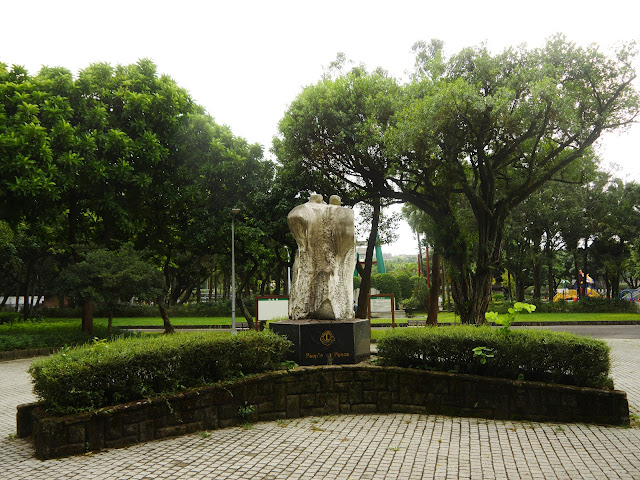















































































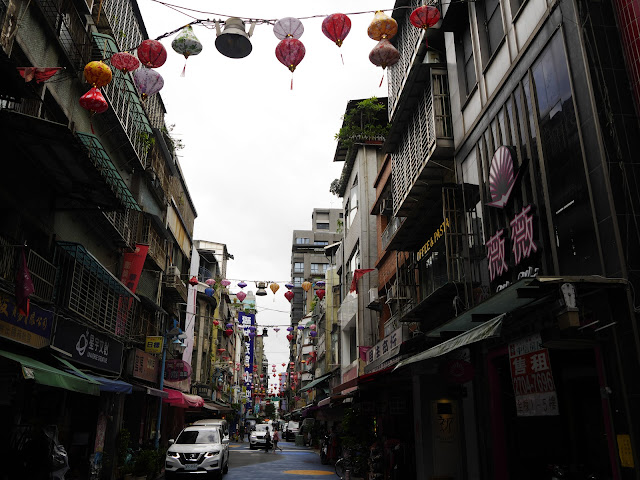


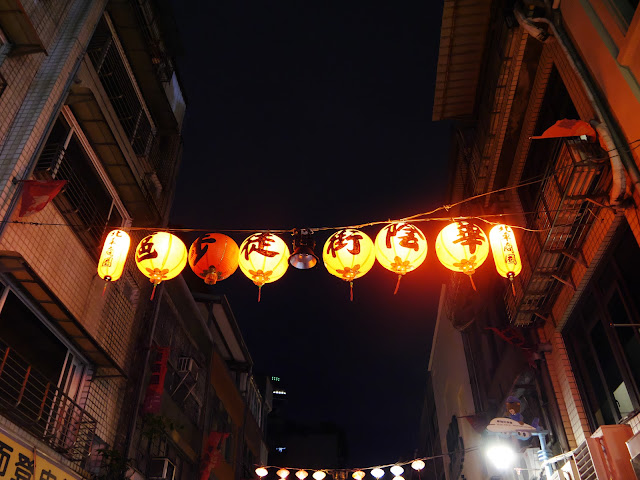
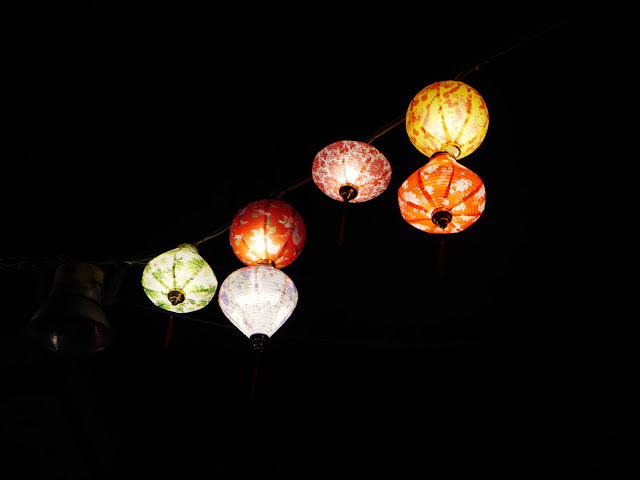





































































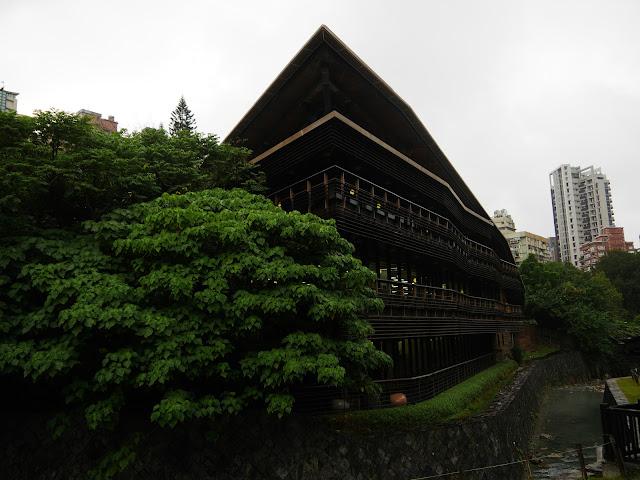


















































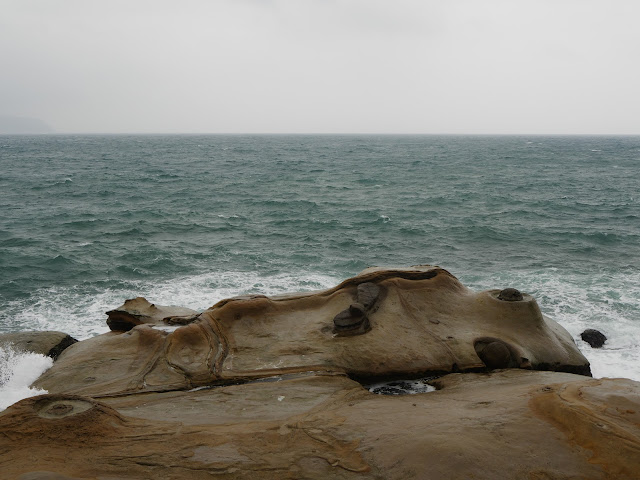
















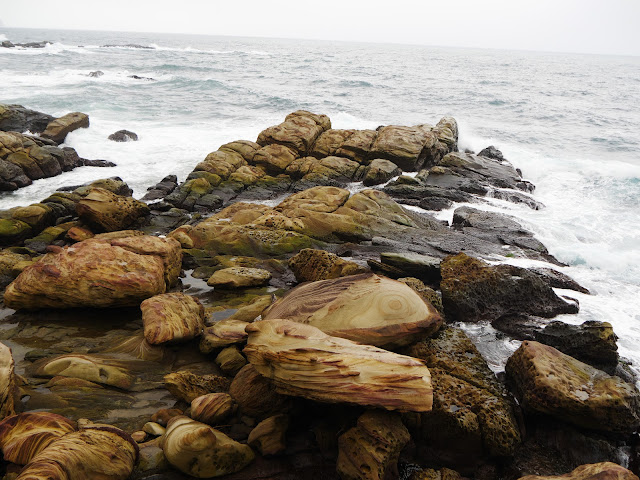



















































































































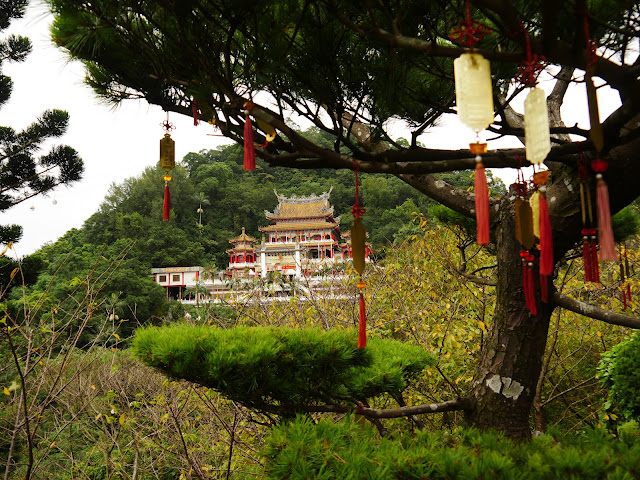





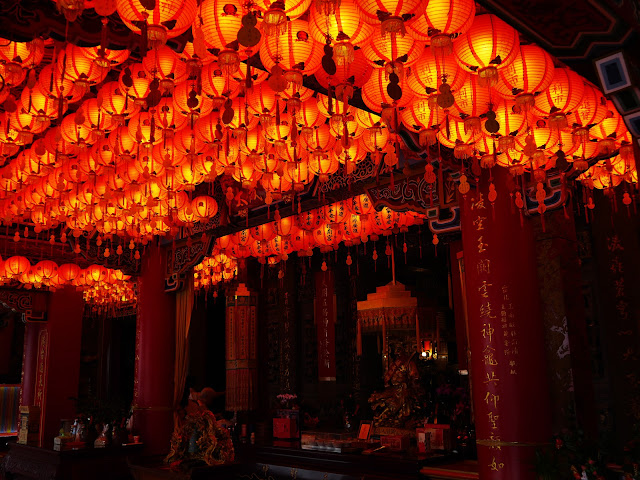








































































































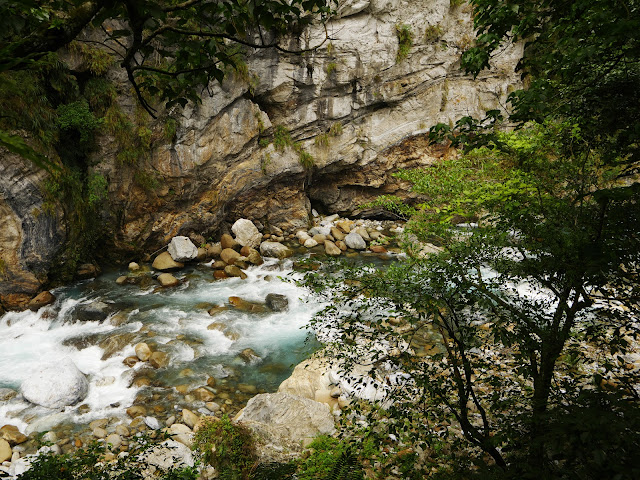











































Comments
Post a Comment